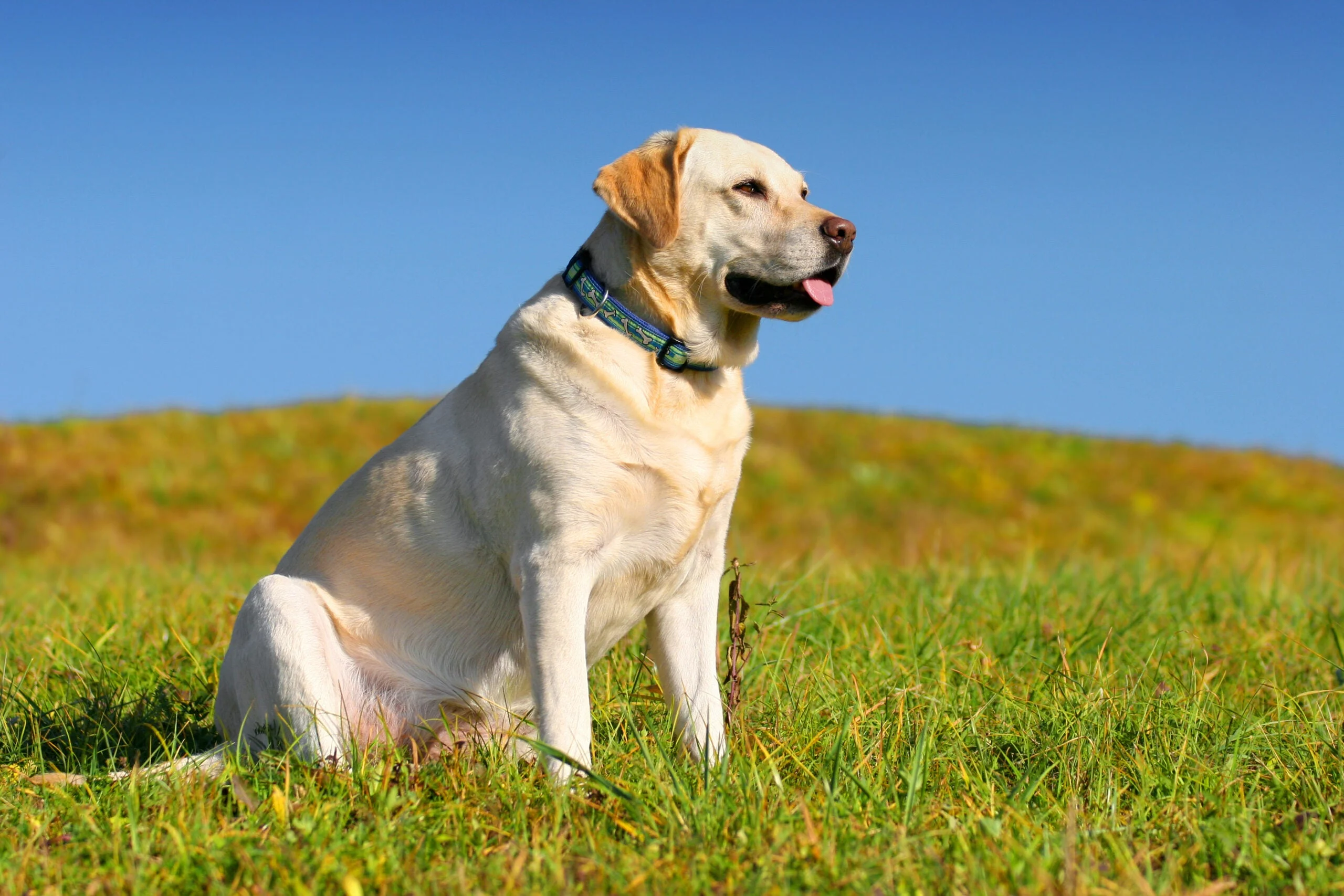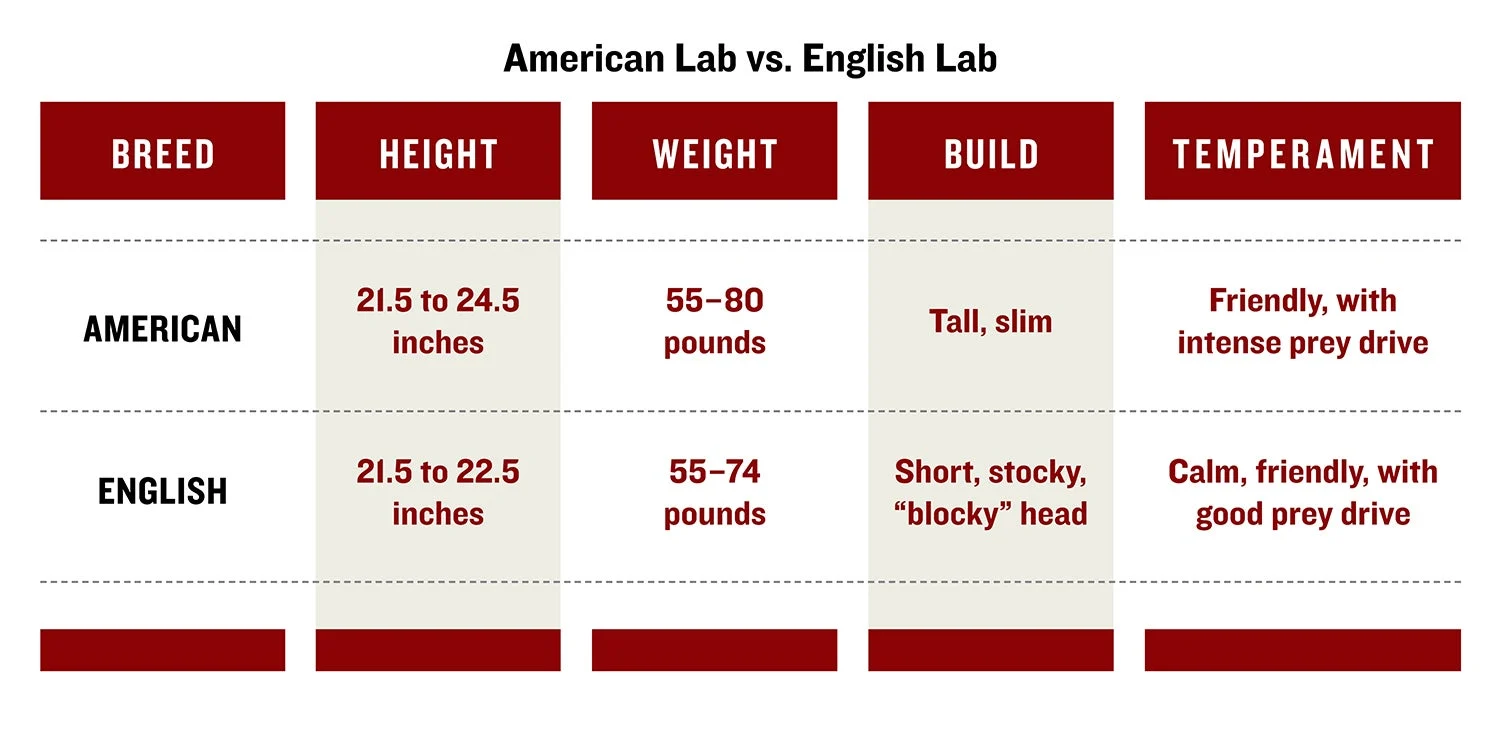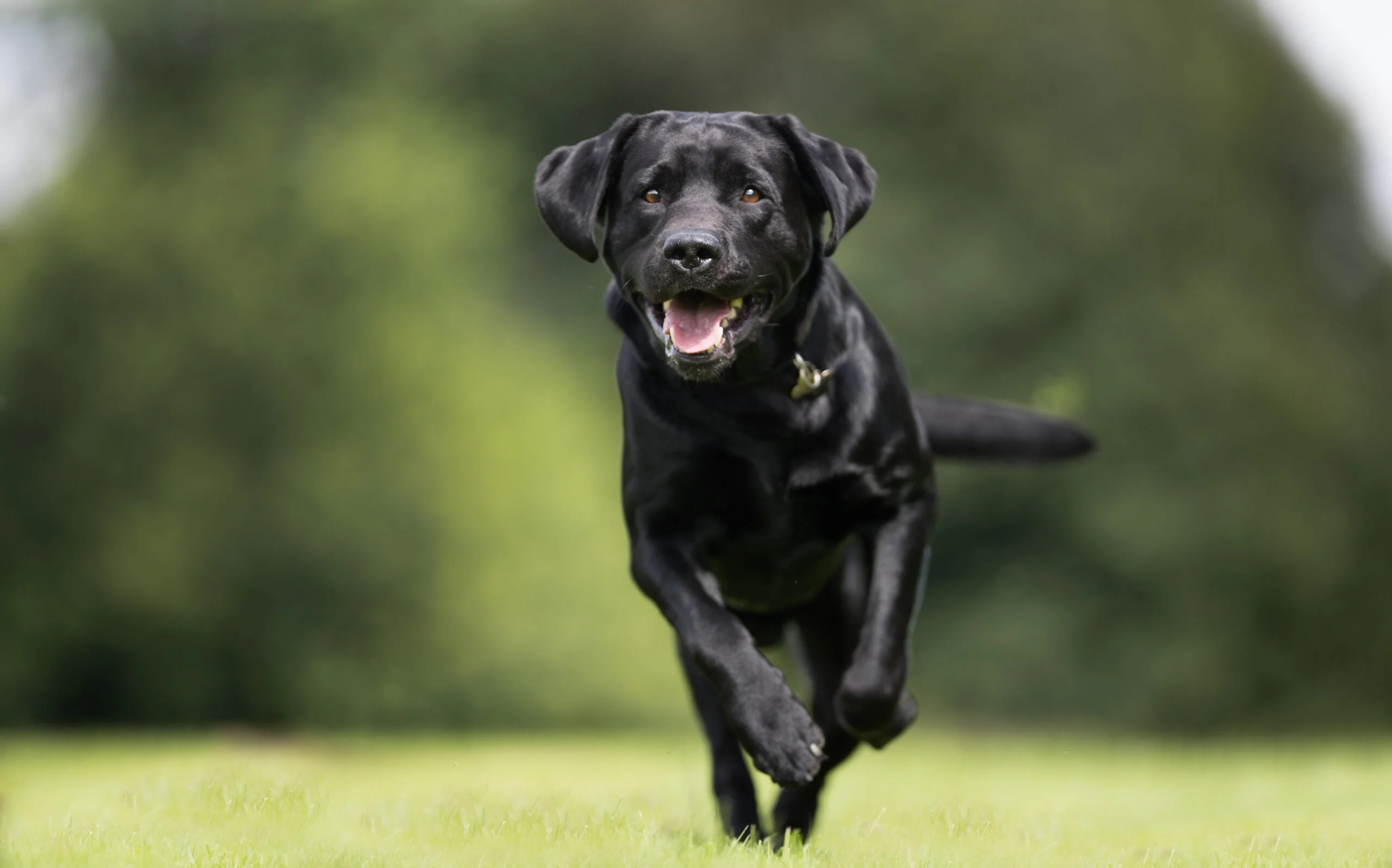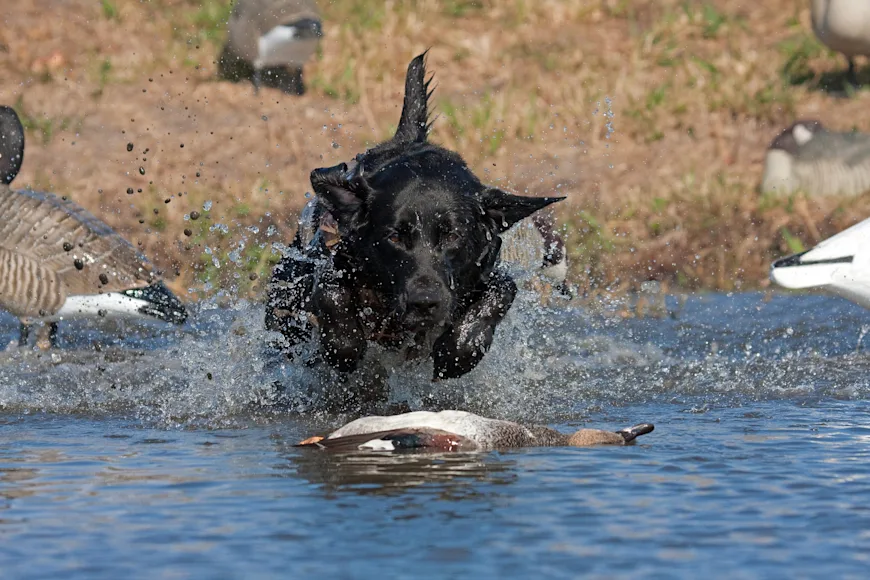America’s most popular gun dog, the Labrador retriever, is bred for the water, yet it’s also equally at home in the uplands and in the house. Labs make great all-purpose hunting and family dogs, and it’s no surprise that a lot of people—possibly including you—are thinking about a Lab puppy. You have choices to make as you search for a breeder. One of the first decisions you make is choosing between an English Lab vs. American Lab. American and English Labs are not separate breeds, but in the 100 or so years since Labs came to America, Labs bred for the needs of American hunters and field trailers have been bred to enhance certain characteristics that distinguish them from the Labs seen in England.

A tank of an English Lab takes a sit in the country. Tinka via Adobe Stock
The ancestor of all Labs—and of several other retrieving breeds—is the St. John’s Dog of Newfoundland, a fisherman’s dog, bred and trained to haul lines, nets, and even cod sometimes. The result of a mix of English, Irish, and Portuguese water dogs, St. John’s dogs were black with white “tuxedo” patches and were prized as biddable, hard-working companions. St. John’s dogs came in two sizes, greater and lesser. Englishmen visiting Newfoundland in the early 1800s brought lesser St. John’s dogs back with them, and used them as the basis for a number of retriever breeds, including the Labrador. Greater St. John’s dogs went on to become Newfoundlands.
**Read Next: The Best Hunting Dog Breeds
**
All Labs have water-repellent coats, extra webbing between their toes, and thick tails to help them steer in the water. They come in black, yellow, and chocolate. Labrador retrievers were recognized as a breed in England in 1903, and by the American Kennel Club
in the United States in 1917. And although they are not separate breeds, English and American Labs have their differences, both in appearance and in temperament. Learning more about the distinctions between English Labs vs. American Labs will help you decide which type best suits your needs.
Physical Differences in an English Lab vs. American Lab
When it comes to looks, there is a difference in the English Lab vs. American Lab. English Labs are often shorter than the American kind. English breed standards specify a height of 21.5 to 22.5 inches at the withers (highest point on the shoulder), while American Labs range from 21.5 to 24.5 inches. That size difference carries over to weight. Typically, American Labs are bigger than English Labs
. While the breed standards permit 55 to 74 pounds for English Labs and 55 to 80 pounds for American Labs, we have all seen 100-pound American Labs in the field.

English Labs conform more closely to the original breed standards, and are generally thought of as stockier than their American cousins, fuller through the neck and chest, with blockier heads and shorter legs. American Labs, in contrast, are taller, slimmer, with sleeker head, longer muzzle and legs. English Labs have thinner tails that curve upward while American Labs have thicker, straighter tails.
English Labs have heavier coats, usually, although both English and American Labs have water-resistant, double coats that help them withstand cold, wet conditions. And both kinds comes in three main colors: black, yellow, and chocolate. Chocolate dogs are rare, especially among English Labs, because the trait is recessive and breeding for the chocolate color can result in poor genetics and health problems.
Temperament in English and American Labs

A black Lab runs a retrieving drill in the offseason. Mikkel Bigandt via Adobe Stock
Although the primary job of both American and English Labs is to find and retrieve fallen game, they go about it in slightly different ways, in part because of what field-trial judges look for on opposite sides of the Atlantic. English judges look for dogs that can remain calm and perform despite distractions. English labs are often used as pick-up dogs during driven shoots and they are expected to behave in the midst of lots of people and activity. Therefore, the stereotypical English Lab is a mellower dog than an American Lab. An English Lab is laid-back, but still with a strong drive to find downed birds and retrieve them. And, the lower-key temperament also means English Labs are biddable, highly trainable, and even a bit “soft,” so you wouldn’t want to train them with heavy hand. “Laid-back” is a good quality to have in a house dog, too.
The stereotypical American Lab is a very affectionate family dog—if sometimes rambunctious. If you own an American Lab, you risk having everything swept off your coffee table at any time by a tail that never stops wagging.
American Labs, both due to the nature of the American field trials they are bred for and because they are used for waterfowl hunting, are typically more energetic and excitable. The stereotypical American Lab may be a little headstrong as well. They are still very affectionate family dogs—if sometimes rambunctious. If you own an American Lab, you risk having everything swept off your coffee table at any time by a tail that never stops wagging.
Hunting Differences
Both English and American Labs are good duck hunting dogs
. They’ll both flush and retrieve upland birds as well. Typically, the American Lab is the more intense, higher-energy, higher-drive dog, and according to its fans, the better choice to hunt every day of duck season, or to make countless retrieves during a spring snow goose hunt. English Labs might be better suited to weekend hunters and first-time Lab owners who want a dog that’s easy train, lower-key, but can still retrieve limits of ducks.
Size is another consideration. American Labs run bigger, giving them an advantage in powering their way through heavy cover or cold, icy conditions. English Labs run smaller, which can be a real consideration when you need to fit a dog into a smaller kennel or lift it over a fence.
All of the differences in an English Lab vs. American Lab—hunting traits, temperament, and even size—are generalities. There are laid-back American Labs and intense English Labs. It’s important when you choose a puppy to research breeders. Find out what traits they breed for, and, if possible, see the puppy’s sire and dam in the field and around people.
FAQs
Are American labs easy to train?
American Labs are smart and eager to please, and they can be trained to perform many tasks. They can be trained to handle complex hunting chores such as multiple blind retrieves in the duck marsh. Labs are also used for a variety of non-hunting jobs such as bomb and drug detection, seeing eye dogs, support dogs and more. Their trainability and skill at swimming makes the good water rescue dogs, too.
What is the rarest type of lab?
The three main Lab colors remain black, which is the most popular, then yellow, then brown. The rarest Lab is the silver, which is actually a chocolate Lab with a dilute gene that gives it a silver-gray coat. They are often mistaken for Weimaraners, or thought to be Weimaraner-Lab crosses, but they are 100 percent Labrador. There are also champagne, white, and red Labs, all of which are simply color variations of the yellow. Charcoal Labs, like silvers, have a dilute gene that lightens black coats to a charcoal gray.
Where are American labs from?
American Labs are descended from the lesser St. John’s water dog, as are English Labs. English hunters visiting North America in the early 1800s were impressed by dogs Newfoundland fishermen used to retrieve nets, lines and fish. They took the dogs back to England and crossed and bred them as hunting dogs. Labs came to America in the early 1900s, and were recognized by the AKC in 1917. From then, the American strain of Labrador retriever was developed, as a bigger, taller, intense and athletic dog than its English counterpart.
What are English labs known for?
English Labs are known for their ability to retrieve waterfowl, and to flush and fetch upland game. They were developed not only to retrieve waterfowl, but as “picking up” dogs at driven pheasant and partridge shoots. At those shoots English Labs had to wait calmly throughout the shoot, before retrieving fallen birds. Typically, they are smaller than American Labs, softer in temperament, and lower-key. They are easily trainable and make excellent hunting companions and house pets.
Final Thoughts on the English Lab vs. American Lab
There is no better choice than the Labrador retriever for an all-around duck-retrieving, upland-bird-flushing, family dog. Choosing between English Lab vs. American Lab can help you find the best puppy for your needs. If you’re a hardcore waterfowler who hunts every day of the season, you may need the size and intensity of an American Lab. If you want a dog that isn’t quite so high-energy but will still hunt birds and retrieve waterfowl, a smaller, mellower English Lab might be the right choice.
Choosing between American and English Labs is only the first step in your research to choose a puppy. There can be as much variation within different types of dogs as there is between the types. Get references from your breeder and talk to people who have their dogs. If you can, see parents work, which will give you a good idea of what your puppy will be like.






